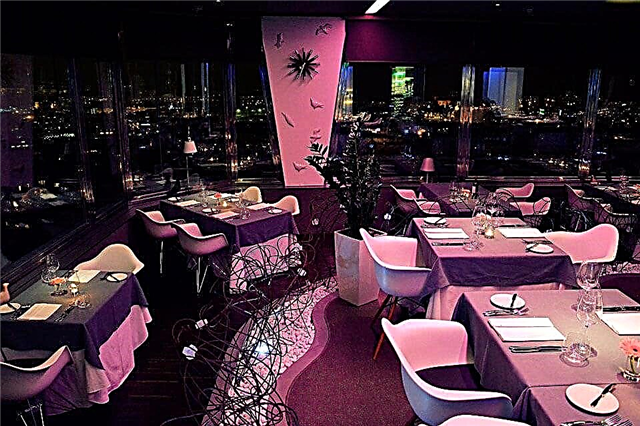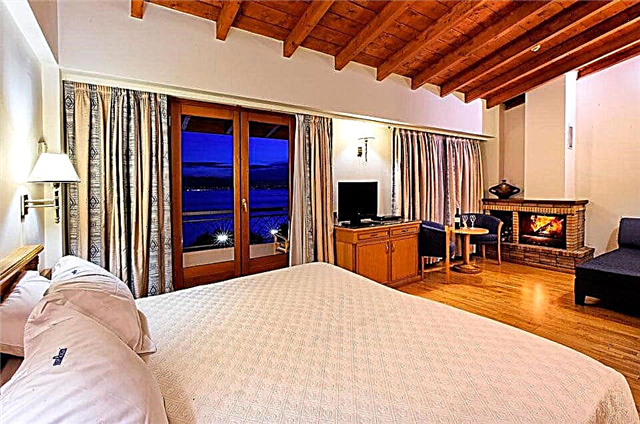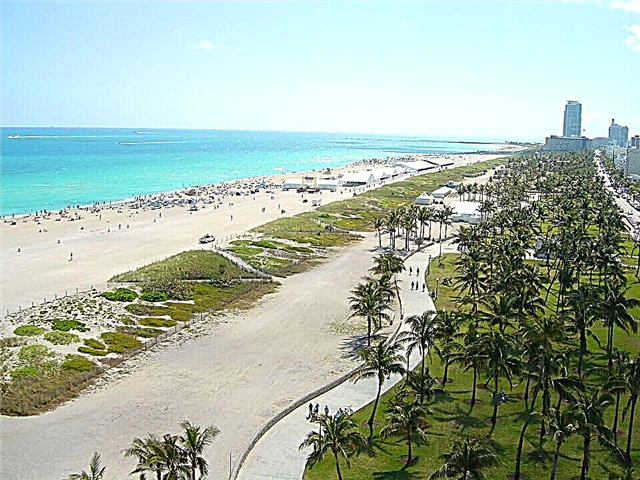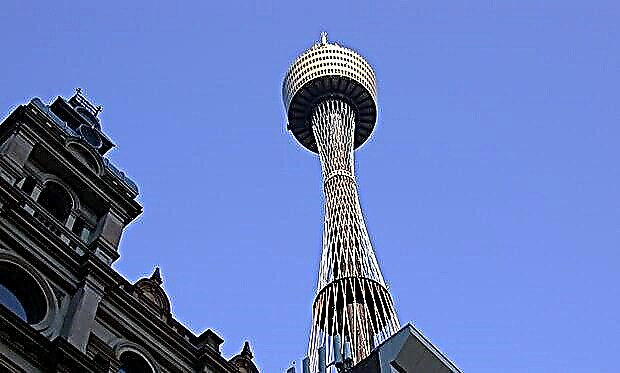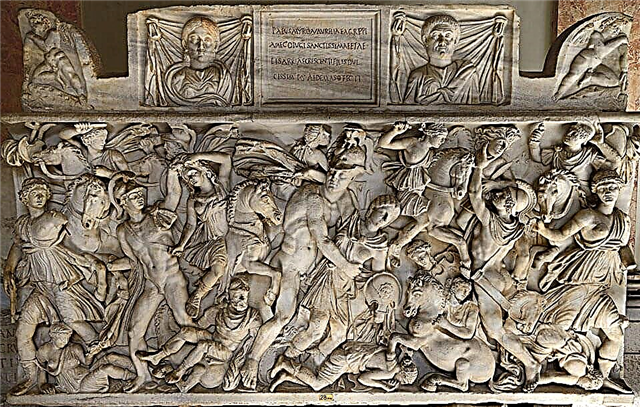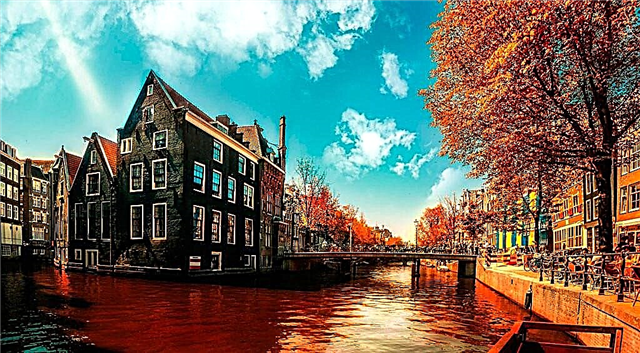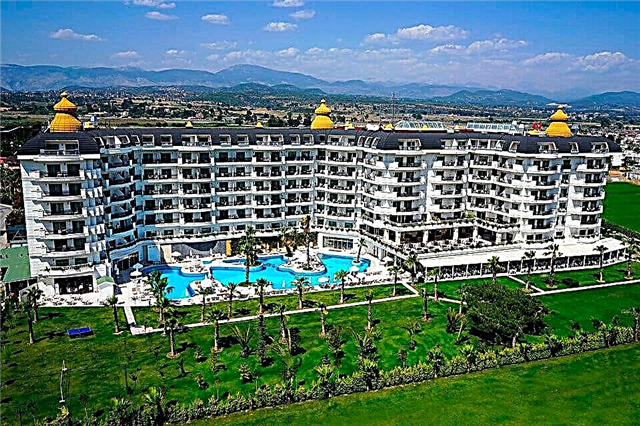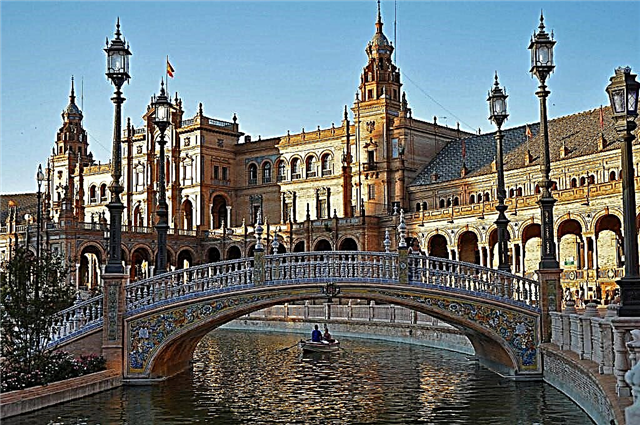Seville is perhaps the most famous city in Spain after Barcelona. The number of historical and architectural monuments in it is so great that on almost every street you can find buildings or statues that have their own long history. The capital of Andalusia is not a millionaire city - about 700 thousand people live in it. Tourism, services, industrial production are the main sources of income for local residents. The main attractions of Seville are located on both banks of the Guadalquivir River, streets and squares adjacent to it. There was a "Golden Age" in the history of the city, when the discovery of America, the wealth exported from the New World, created the basis for the development of the province. The Napoleonic Wars undermined its economy. The city revived during the industrial boom, but it was replaced by new wars, Franco's repressions, mass shootings ... It seemed that this place would never be resurrected. The fortitude of the inhabitants of the city won everything.
Cathedral

It is rightfully one of the three largest and most ancient temples on earth, and some of its buildings still retain their original appearance. The beginning of its construction dates back to 1401. In addition to its impressive dimensions, the cathedral amazes visitors with the luxury of its decoration. Its interior is a mixture of different styles that complement each other harmoniously. Here you can find carvings made in the Gothic style, icons, paintings by Roelas, Morales, Leal, Murillo and other eminent artists, copper embossings, jewelry, plateresque lattices and other works of art.
You can get to the temple through one of nine gates, passing through which you get into spacious halls. In one of them, the attention of visitors is attracted by the tabernacle made by the master Harp, who called it his best work. Also noteworthy are the stained glass windows, on which various famous artists have worked for a long time. But, of course, the main attraction of the cathedral is the remains of Christopher Columbus that have survived to this day, placed in a coffin held on their shoulders by four stone giants.

In addition, the temple contains the burials of Cardinal Cervantes, Dona Maria de Padilla, Alphonse the Wise and Pedro the Cruel. But at the foot of the patroness of Our Lady of los Reyes, you can see the body of Saint Fernand III, untouched by decay. The largest number of visitors gathers in the Cathedral during Holy Week and on the day of the Assumption of the Virgin. But in April, an annual fair opens in front of its entrance, where you can buy all kinds of goods of folk craftsmen, as well as watch or even take part in the carnival.
The Cathedral opens its doors to visitors at 11.00, so if you want to see the sights of the city before noon, this place can become another point on the tourist route. Those who prefer to pay attention to excursions in the evening should remember that the cathedral closes at 17.00.
Giralda

The tower, about 98 meters high, is one of the city's hallmarks. Giralda is associated with Catholicism, but it is Islam that owes its appearance to a unique architectural monument. The tower was erected at the beginning of the 12th century during the Arab rule. For 100 years, the Giralda, decorated with 4 gilded balls, was a minaret and the largest observatory in Europe. When the Pyrenean Christians conquered the city, the mosque next to the tower was rebuilt into a cathedral. The Giralda became his bell tower.
The quadrangular tower is called a monument of Moorish architecture, which is not entirely true. Part of the building was destroyed, all elements of the Giralda above 70 meters were created after the Muslim rule and correspond to the canons of the Spanish Renaissance. In the 16th century, a bronze weathervane statue was erected at the top of the tower. She symbolizes one of the basic Christian virtues: Faith.
In honor of the statue, the structure was named: Giralda translated from Spanish means "weather vane". The bells installed 500 years ago on the belfry of the tower are perfectly preserved. Inside the Giralda, there is an exhibition of medieval household items on a permanent basis. The open terrace of the bell tower serves as an observation deck.
Torre del Oro

Literally translated, the name means: "golden tower". Torre del Oro was designed to monitor the harbor and conduct combat operations. The Mauritanian twelve-sided tower, 37 meters high, served as a fortress. Its counterpart - a similar structure on the other side of the river - has not survived. Historians date the construction of the towers to the beginning of the 13th century. The buildings were connected by a chain located in the water. It was raised and lowered with the help of special devices.
A simple structure in a matter of minutes closed the entrance to the harbor for enemy ships. During the Muslim domination, the tower was decorated with magnificent gilded tiles, in honor of which it, according to one version, was named. Later, the building served as a repository for gold exported by the Spaniards from America. Local residents are sure that the treasures belonging to the slain Indians have drawn a curse to the ancient tower.
Torre del Oro was damaged by earthquakes, and people died during repair work here under strange circumstances. The building was turned into a prison, a chapel, a port warehouse, and the tragic coincidences continued. Today, the tower houses the Maritime Museum, whose collection of ship models, navigational instruments, and ancient weapons is considered one of the best in Spain.
Alcazar Palace

It is worth warning right away that it will take a whole day to see this attraction. From October to March inclusive, it is open to visitors from 9.30 am to 5 pm. But from April to September - from 9.30 to 19.00. It is worth mentioning that on Mondays, at certain hours, you can enter the palace free of charge. But on other days you have to come here early in the morning to take a lot of tickets, the cost of which is 9.50 €.
The Alcazar Palace is located in the center and is a monumental structure in which various architectural styles and trends are harmoniously intertwined. You can get into it through the Lion's Gate, which got its name from the coat of arms with the image of a lion located on it. The gate is decorated with bright scarlet ceramic masonry, which immediately stands out against the background of light walls.
The center is the Palace of Pedro I, the Throne Room of which is crowned with a gilded vault, decorated with unusual ornaments made of wood and symbolizing the infinity of the universe. Below you can see a frieze on which portraits of Spanish monarchs are applied. Next to the Palace of Pedro I, there is a building that housed the residence of Charles V, made in the Gothic style and decorated with ceramic mosaics.
The Alcazar Palace also has a room called the Maiden's Patio, which is famous for its exquisite interior, decorated with friezes, tiles and stucco moldings, distinguished by special elegance and sophistication. The feeling of luxury is complemented by the gardens, which have many fountains, gazebos and lawns, along which, like many centuries ago, royal peacocks stroll. The garden is filled with the fragrance of all kinds of flowers, orange and other exotic trees, which are carefully trimmed and formed into the right ensembles.
The Alcazar is now officially the seat of the Queen of Spain.It will take more than one day to fully describe this architectural structure, so it is better to see it yourself once and form your own opinion about its magnificence.
Spain square

It is impossible not to visit the Plaza de España. Despite its modest size (its diameter is only 200 meters), it attracts tourists with such attractions as:
- An unusual semicircular palace, covering the area from almost all sides
- Luxurious fountain, located in the very center of the square, with beautiful "mirror" streams
- But for fans of the Star Wars movie, it is a cult place, since some of the scenes were filmed here.
An interesting feature of the Plaza de España is the fact that here pigeons are not at all afraid of people and eat food directly from their hands. The square is surrounded by a canal, which can be used for boat trips for a reasonable fee. Tourists are warned by guides that it is not worth buying souvenirs from random merchants on the Square, as they are much cheaper in shops. Tired after excursions and walks, you can have a snack in one of the local restaurants. On average, lunch will cost 15–20 euros, and a cup of cappuccino - 1.5–2 euros.
Metropol Parasol

An unusual construction of fantastic forms is located in the Plaza de la Encarnacion, which attracts all visitors with its unusual appearance. Crowds of tourists come to the futuristic building to take a closer look, go inside and make sure that there are halls, corridors, like in ordinary buildings. Looking from the outside at the huge lattice "wings" open over the square, it is hard to believe that they are made of wood (Finnish birch). Indeed, the Metropol is by far the largest and most original wooden structure in the world, striking the imagination in size and unusual configuration.
The history of its origin is interesting: until 2009, there was a city market on this place, during the demolition of which the remains of buildings of the Roman era were discovered as a valuable historical monument. To preserve it, the authorities established a competition to create a design for a structure containing ancient ruins. He won the project of the German architect Mayer-Hermann, who received a prestigious award in the field of architecture after the completion of the construction.
In fact, Metropol Parasol is a gigantic complex consisting of separate structures, resembling huge umbrellas, mounted on massive columns connected to each other. The total height of the four-tiered structure is 26 m, the length is 150 m, and the width is 70 m. The Archaeological Museum is located in the underground rooms, where majestic ruins appear to the eyes of those present; the ground floor is occupied by the Central Market; the roof of the 1st level is presented in the form of an open concert area; on the 2nd and 3rd levels there are terraces from where guests can admire the beautiful panorama of the city and the bizarre curves of Parasol itself.
Archive of Indies

Rarely does a country, let alone a city, boast such a unique treasure as an invaluable collection of documents reflecting the course of the history and development of Seville and Spain as a whole. There is evidence of the activities of such great Spaniards as Cervantes (his official request) and Christopher Columbus (the maritime journal of the discoverer); plans of urban buildings, the first maps of Magellan, the originals of manuscripts of philosophers and writers.
From the materials of the archive, you can find out the most accurate information about the conquistadors and their participation in the conquest of America, about the role of Spain in the fate of the Philippines and about many other historical facts. The pages of rare documents reveal the true past of the city and state, therefore the archive is a favorite place for ethnographers, historians and politicians. Now on the shelves of the archive of the Indies (total length - almost 9 km) there are 43 thousand volumes of true rarities - they have something to work with. Researchers studying documents need special permission.
Tourists are also interested in this object, the contents of which connect eras and centuries. Its history began in 1572, when King Philip II commissioned the local architect de Herrera to design a building for the guild of Seville merchants. Construction began 7 years later and lasted 14 years until 1598, and the interior decoration was carried out already in the 17th century. The magnificent building of the archive, erected in the Renaissance style, is an undoubted masterpiece of architecture and a historical monument. The interiors are just as majestic and monumental. Restorations have been carried out here several times, aimed at preserving the unique cultural and historical object.
Address: Edifico de Lonja Av, de la Constitucion, 3.
Town Hall

The Town Hall is not just an administrative building, but an old architectural monument, striking the eye with its chic appearance and graceful beauty of design. The Town Hall is unique in that since it was built (1527) as the residence of the city authorities, it has never changed its status. The reason for its construction was the royal wedding of the ruler of Castile Charles and the Portuguese princess Isabella. For the building they chose a purely Spanish style "plateresco" - one of the types of the Renaissance, the characteristic features of which are decoration of facades with patterns of the finest carving, similar to openwork lace.
Almost the entire building has been preserved in its original form, except that in the 19th century. added one more main entrance (now it is the central one), where the features of the new classical style appeared. To see the beautiful details of the "plateresque", you need to walk around the building and admire the unfading beauty of the old design, sculptures a la grotesque, heraldic symbols of the city. The new main entrance overlooks Nueva square, and the old one - on the square. de San Francisco. The exterior of the Town Hall can be viewed at any time, and an internal inspection is possible only with a guide as part of a tourist group (at least 45 people).
Open for visits: Monday-Thursday, Sat - time depends on the work of the administration.
Hospital of the Five Sacred Plagues

A monumental rectangular structure with intricate towers at the corners, in fact, is an architectural complex, with an old beautiful garden, a labyrinth of trimmed bushes and benches for rest. It has a long history, dating back to the 16th century, when a wealthy Sevillian nobleman bequeathed to build a large hospital for the poor at his expense. The will was faithfully executed and the result was a solid Renaissance building with 10 courtyards.
The central facade, decorated with original stucco ornaments, makes the ordinary hospital building a real architectural masterpiece. Particularly noteworthy is the local old Baroque church, with many decorations made of artistic carvings. For many years the hospital treated the poor and the soldiers free of charge; the nurses were nuns from local monasteries.
The noble cause of health restoration continued until 1972, after which the complex was empty for almost 20 years. Having decided that it was unforgivable to leave such a capital structure abandoned, the local authorities began to restore it, and in 1992 the Parliament of Andalusia was housed in a renovated, comfortable building. The 5 Sacred Wounds Hospital is an interesting tourist attraction.
Palace of San Telmo

It is impossible not to pay attention to this long terracotta building with many windows and fanciful details - it is striking with a style that is not quite typical for Spain - intricate ultra-baroque in the Mexican spirit. In 1754, upon completion of construction, a naval school was first placed here, a century later - a university, then a seminary. Currently, the regional administration of Andalusia works in it.The authorities tried to preserve the historical appearance of the unique building, and after reconstruction it appeared in its original form.
The design elements of the central façade and entrance are true works of art: 6 elaborate columns are crowned with magnificent figures of Atlanteans, serving as a support for a carved balcony with 12 graceful female statues - symbols of marine sciences. Above, there are sculptures of 3 patron saints of Seville, among whom Telmo is the patron saint of sailors. 12 sculptural statues of great citizens are located along the balustrade. The local church is also an ultra-baroque masterpiece with a large number of sculptures, magnificent decorations and rich decoration.
Address: st. Avenida de Roma, 21.
Maria Louise park

A truly beautiful picturesque corner - the main park, founded in the 20s of the last century in preparation for the event. Ibero-American Industrial Exhibition. It is named so in honor of Queen Marie-Louise, who donated to the city a piece of land on which the gardens of St. Telmo, and then they laid out the park. And now 2 pavilions of that time have been preserved, on the territory of which the Museum of Folk Arts and Crafts and the Archaeological Museum are located, exhibiting a huge number of interesting objects.
Among the beautiful lawns, ponds, in cozy alleys, there are monumental monuments to the famous Spaniards. Wonderful rose gardens, flower beds, unique fountains, blooming orange trees, oleanders, pyramidal cypresses make the park an irresistibly beautiful place. Its landscapes are intertwined with Moorish, Renaissance and Gothic motifs, creating amazing landscape paintings that are definitely worth seeing.
Church of St. Luigi French

The construction of the temple began in the 17th century and lasted for about 100 years. Initially, the building belonged to the Jesuit order, then to the monastery. Within the walls of the church at different times there were a theological seminary, a hospital, a hospice. Today the building that houses the museum belongs to the city. The church was built in the Baroque style. The authorities have invested funds to restore the interior and exterior of the temple, its towers, columns, dome. The cross-shaped building is not a place of pilgrimage, but the artifacts located here are of particular value to believers.
The restorers managed to restore the paintings on the church ceiling, unique carved decorative elements, paintings, figures of saints. The altar is recognized as a true work of art in the ultra-baroque style. It is distinguished by an abundance of small details, however, the design does not create a feeling of heaviness, because all the parts are combined into a harmonious ensemble. It is hard to imagine that these items were made by craftsmen from different schools. Artists, sculptors, restorers have succeeded in the almost impossible: to preserve the unity of the stylistic solution.
Murillo gardens

Tourists and locals call the most beautiful of the Spanish parks a green paradise. It is not the only one on the territory - the city is famous for its numerous recreation areas. However, the Murillo Gardens, opened to the public in the last century, have become one of his business cards. The great Spanish artist, whose name the park bears, was fond of landscape painting, boldly included elements of realism in his works.
The main works of Esteban Bartolome Murillo are devoted to biblical subjects, the glorification of the Virgin Mary, the deeds of the saints. His mystical, sublime vision of the world seemed to be transmitted to the creators of the park, where a light and at the same time solemn atmosphere reigns. The gardens occupy an area of about 10 thousand square meters, previously the site belonged to the royal castle. One of the attractions of the park: a monument to Christopher Columbus. All of its details are deeply symbolic. Leo means Spain.
Two snow-white columns directed upwards are Europe and America. Located in the middle, a ship with the names of the king and queen who financed Columbus's expedition connects the columns-continents. The gardens are famous for their fountains. One of them is named after another great Spanish artist from Seville - Jose García Ramos.
House Museum Murillo

The mansion received the status of a museum in 1972. After 10 years, it was opened to the public, becoming an important part of the most popular Spanish tourist routes. Esteban Bartolome Murillo was born and died in Seville. The artist spent the last years of his life in this two-story building on the cozy St. Teresa street. The interiors of the bedroom, living room, kitchen are fully consistent with what they were during Murillo's life in the 17th century. The museum has a collection of paintings, personal belongings of the great master.
The central character of his works: the Virgin Mary. He harmoniously combined Catholic church canons and elements of realism in his frescoes and paintings. Esteban Bartolome gave the images of the Purest features the indigenous inhabitants of Andalusia. As models he chose representatives of the common people, which at that time was equal to a challenge to public taste.
Murillo created about 500 works, the main customers of his works were churches and monasteries. The main theme of the master's work: deeds of mercy. Esteban Bartolomé preached Christian values by personal example: he led a moderate lifestyle, helped the poor in Seville, and set free slaves before his death. The artist is not famous for carousing, scandalous novels, eccentric antics. Fate gave him family happiness. At 47, he remained a widower and never married. Five children followed in the footsteps of Murillo, but did not reach their father's creative heights.
Maestranza bullring

The beginning of the construction of the pompous structure dates back to the 18th century. It is the most famous bullring in Spain. The construction of the facility took about 120 years. At the same time, 14 thousand people can be on its territory. The arena forms a single architectural ensemble with a chapel and a hospital located nearby.
Performances are held from spring to autumn, after the death of dictator Franco, women bullfighters perform here again. Prayer before the battle in the chapel is an essential part of the preparation for battle. Monuments to the famous bullfighters are located at the entrance, the bullfighting museum is inside the building. Any bullfighting arena is a mystical place, and Maestranza is no exception. On days when there are no performances, the Spaniards try to avoid the topic of bullfighting in any conversations in order to preserve the goodwill of fate.
A bullfighter does not always emerge victorious in a fight with an angry animal, and an unnecessary mention of the word "bullfight", according to local residents, brings misfortune. Maestranza is located on the boulevard of Christopher Columbus. Its facade is a 30-sided polyhedron. The monument to the gypsy woman Carmen was erected here. The heroine of Prosper's novel Merimee seemed to be frozen in motion for a moment, heading for the place where she was to die at the hands of her lover.
Royal Tobacco Factory

The first tobacco factory built in Europe is recognized as a monument of industrial architecture of the 18th century. Military engineers supervised its construction. Seville at that time had a monopoly on the sale of tobacco imported from America. The raw materials were processed manually. The production of cigarettes required special conditions due to the toxic properties of tobacco dust. The enterprise was taken out of the city wall, where it functioned stably until the middle of the 20th century.
The factory went down in the history of the world literary, musical heritage as the place of work of Carmen - the heroine of the famous novel by Prosper Mérimée and the opera of the same name by Georges Bizet. Today it houses the administration and several faculties of the University of Seville. The entrance to the building is free, but there are restrictions on the inspection - so that tourists do not interfere with the students.
Since its construction, the exterior of the tobacco factory, which repeats the shape of a rectangle, has remained almost unchanged. The facade decorated in the Baroque style is striking in its splendor.When the university moved, adjustments were made to the internal layout of the building. Arches, panels, paintings of the courtyard have been preserved in their original form.
Bridge of San Telmo

The history of the building dates back to 1917, when the local authorities held a tender for projects. Spanish and French architects presented various options for the bridge over the Guadalquivir River. The construction of the structure ultimately turned into an endless story of budget savings on everything. The width of the bridge was reduced to 15 meters, and the decor elements proposed by the architects were abandoned. The first tests were carried out on August 13, the date caused superstitious horror among the population: the bridge was unanimously predicted an unhappy fate.
Its maintenance, repairs have become a significant item of expenditure for the city budget. Initially, the structure was lifting, but by 1961 the mechanism was worn out. Overhaul failed to rectify the situation. As a result, the bridge, where the pedestrian zone remained, became stationary. To increase its carrying capacity, create conditions for traffic, it was necessary to reconstruct and increase the width of the spans to 18 meters. The monumental structure is popular with tourists and guests of the city, but losses from it continue.
Church of Santa Maria la Blanca

The fate of the building resembles a simple truth: history, like the road, is full of surprises. The mystics call the site where the temple was built a place of power. It is difficult to argue with this statement, because representatives of different confessions were attracted by this particular area. The building of the Catholic church alternately housed a mosque and a synagogue.
It begins its history from the time of the Moorish rule. Scientists give different dates for the construction of the mosque, which turned into a synagogue in the middle of the 13th century. By the end of the 14th century, the building was taken over by the Catholic Church, followed by further renovation work, redevelopment of the interior, and reconstruction of the facade. Each of the confessions contributed to the internal and external decoration of the temple.
Paradoxically, it was the various style solutions that allowed the building to find special harmony. Bas-reliefs, stucco moldings, columns, arched structures, figured and floral ornaments - according to the elements of the temple's decor, as art critics joke, one can study Gothic, Moorish applied art and Andalusian Baroque at the same time. The temple has preserved the works of the great Spanish artist Murillo, frescoes by unknown masters of the 15th-17th centuries.
Adriatic building

The age of the architectural masterpiece: a little over 100 years old. The building was named after the insurance company that invested in its construction during the construction boom in Spain. La Adriatica is intended for office space, but outwardly resembles a luxurious palace, where French eclecticism and the Seville version of the neo-Moorish style are mixed. Towers, columns, balconies, stucco moldings, arched decorative elements form a single ensemble. Contrasting colors, a dome with a weather vane emphasize the uniqueness of the structure.
The management of the company financed the construction of similar buildings in different parts of Spain. It was a profitable investment in the implementation of ambitious creative projects. The objects were erected in the historical centers of settlements. However, the architects managed in all cases to emphasize the uniqueness of the cityscapes surrounding the new buildings.
Flamenco Museum

The private museum is located in an 18th century house in the Santa Cruz quarter. Creator and owner of the museum: famous flamenco dancer, choreographer, actress Christina Hoyos. She was born in Seville in 1946 and, having become world famous, founded her own company in the city with the aim of preserving the cultural heritage of Andalusia.
The unique collection of the museum contains exhibits related to the history of flamenco: from castanets, combs, women's dresses, men's costumes - to portraits, sculptures dedicated to a dance theme, and personal belongings of Hoyos. The building serves as a cultural and leisure center. It houses exhibition and rehearsal halls, a 120-seat concert venue, a gift shop, and a bar. The museum conducts flamenco master classes and has a Spanish guitar school on a permanent basis.
The technical equipment allows you to arrange interactive shows, conduct classes online. For young visitors, special entertainment programs are provided. Flamenco dancers perform here 3 times a day. Tickets for those wishing to get to the show are constantly in short supply. To solve the problem, the museum management recently introduced a system for booking seats in the auditorium.
Pilate's house

One of the mystical, mysterious, amazing places. The house never belonged to Pontius Pilate! The building was built on the border of the 15th and 16th centuries. Its architecture is dominated by exterior and interior solutions, made according to the canons of the Renaissance and the local variety of the Moorish style. The history of the building is connected with the Henriquez dynasty - representatives of the highest Spanish nobility.
The direct branches of the clan were cut off 300 years after its construction, and the house remained in memory of the piety of its first owners. The family of the following owners also faded away. In the 21st century, the building belongs to the direct descendants of the Dukes of Medinaceli. They live in a unique building, take care of its safety, allocate significant funds for restoration work.
According to legends: the distance between the ruins of the real palace of Pilate and Golgotha, where Christ was crucified, is equal to the path between the Seville copy of the house of the procurator of Judea and the Cruz del Campo chapel. The annual service of the Way of the Cross (the Catholic Church holds it on Holy Week) in the Spanish city begins with a copy of Pilate's palace. The procession gathers thousands of pilgrims from different parts of Spain and Andalusia. Catholics believe that participation in it frees you from sins.
Church of San Salvador

A cozy temple in the old part of the city, as the locals joke, "hides" from the ubiquitous tourists. The church was built on the site of a Muslim mosque, whose fragments became part of the foundations of a Catholic church. Some guidebooks indicate that it is located on Serpentine Street, in others - in the Plaza San Salvador or Salvador. Visitors to the city who know about the historical site are looking for a temple with a detailed map in their hands and hardly find the second most important church in the city.
The construction of the building began around the 16th century. After 200 years, changes began to be made in its unique architecture, because of the latter, almost nothing remained of the original decoration. The modern exterior of the temple corresponds to the canons of the Spanish late Baroque, however, elements of the late Rococo can be found in the decor. In San Salvador, frescoes on biblical subjects, paintings by Murillo, sculptures by Montaties have been perfectly preserved. Numerous Andalusian pilgrims strive to the "hidden" temple to see the divinely inspired works of the great Spanish masters, attend Mass, listen to organ music, and receive absolution.
Palace of the Countess de Lebrija

An architectural monument of the 16th century is interesting not only as a unique building of its time. The palace houses a museum of art, whose exhibits cover the ancient and medieval eras. A separate section and special rooms are allocated to the oriental masterpieces, which is symbolic for Seville, where the echoes of Moorish rule are still felt today. A dilapidated building was located on the site of the building. The new palace, as it were, merged with it into a single whole.
This made it possible to preserve the unique style "inherited" from the previous structure. The owner of the palace and creator of the museum was one of the most educated women of her time. After her death in 1938, the building changed several owners (relatives of the countess).By the beginning of the 21st century, it was open to the public. The interior of the palace is a unique collection of antiques, paintings, sculptures, furniture, books, decorative elements. The building houses original ancient Roman mosaics, masterpieces of Etruscan ceramics, antique vases, furniture that belonged to the last king of France. The Seville Palace of the Countess de Lebriha was assembled in 13 years literally in parts.
Fragments of the floor were brought from various palaces, the panels for the ceiling - from the medieval castle, the plinth - from the dilapidated ancient monastery. The stunning variety of exhibits does not give the impression of being chaotic. Interior solutions for each room create a sense of luxury, harmony and aristocracy.
Casa de Selinas

Literally the name of the museum in translation from Spanish means: "house of the Selinases". Historians date its construction to the 16th century. The building changed owners several times and gradually fell into disrepair. Representatives of the Selinas dynasty faced the problem of repair, reconstruction of a unique architectural monument at the beginning of the 19th century. The house not far from the royal palace fit perfectly into the architectural ensemble, and it would be a wrong decision to change the exterior of the building, where elements of the Gothic, Moorish and Renaissance styles were intertwined.
The owners opted for an expensive home restoration that was as close to the original as possible. The idea was a success, and Casa de Selinas is recognized as one of the best museums in the city. Externally, the building looks stern. Small windows, massive gates remind of those times when every house in the city, when attacked by enemies, turned into an impregnable fortress. The interior of the Casa de Selinas is a kingdom of light colors, elegant decor, paintings, mosaics, tiles.
Basilica of Jesus del Gran Poder

The Catholic shrine attracts pilgrims from around the world. The small building is about 400 years old. Its neo-baroque façade looks like a toy compared to other churches in Seville. The church has hardly changed since the end of construction, which is the merit of the parishioners and all who donate funds for restoration and repair work. Services in the basilica did not stop during the Spanish Civil War, the fascist dictatorship, when natural disasters hit Andalusia.
The main relic of the temple: the sculpture of Christ, created in the 17th century. It is difficult to believe in its man-made origin - the Savior looks so reliably in the light of numerous candles. The sculptor Juan de Mesa, the author of the masterpiece, lived for only 44 years. According to legend: he invested his life in works that were filled with grace from above. Almost all the sculptures made by the master for the temples have become shrines. Residents and tourists compare the basilica with an island of tranquility in the stormy sea of life.
Alameda de Hercules

The walking public garden was created in the 17th century and later turned into a square with a sonorous name: Alameda de Hercules. For 300 years, a dam existed not far from the territory of the future garden. It provoked a rise in groundwater and caused waterlogging in the area. Count Barajas invested in draining the land, building canals, fountains.
Trees were planted here and columns were installed, two of which are genuine antique monuments. The square gradually regained its usual appearance. Its columns are divided into southern and northern - according to their location relative to the cardinal points. At the top of the first are sculptures of Hercules and Julius Caesar. The first is considered the founder of the city, the second contributed to the development of Seville. The lions at the top of the remaining columns represent Spain and Andalusia.
The square was a favorite resting place for aristocrats before the Spanish Civil War. Later - one of the most dangerous areas where drug trafficking was active. At the beginning of the XXI century, after reconstruction at the expense of the city budget, the square turned into a respectable place for recreation. On its territory there are bars, restaurants, live music sounds, entertainment establishments are open, night life is in full swing.
Church of San Lorenzo

Finding the temple is quite simple - it is located on the territory of the district of the same name. The church was founded around the XIII century, its construction was completed in the XIV century, but this did not mean the end of the process. The increase in the area of the temple was due to new buildings (chapels), which were attached to the main building. The result is an eclectic structure, whose interior and exterior are elements of Baroque, Gothic, Moorish style.
The temple has preserved unique frescoes, whose authorship causes heated debate among historians. The story of the creation of the church altar reminds believers of how ambition can stop a good cause. The first masters who worked on making the altar refused to continue work, which is why the opening of the temple was postponed indefinitely. Representatives of the sculptor dynasty de Ribas saved the day: they created an altar, which has no equal in Spain. The main shrine of the temple remains unchanged: it is a sculpture of St. Lorenzo (Lawrence).
Barket's bridge

The structure connects the banks of the Guadalquivir River, the old quarters and the area where theme parks, entertainment venues, and modern shopping centers are located. The bridge is not a monument of antiquity - its installation was completed in 1992. There are similar structures in different parts of the world. The bridge, according to experts, has increased resistance to mechanical stress. It will continue to function fully in a natural disaster, after an earthquake and flood.
The arch of the bridge is over 200 meters long and is supported by 4 pillars. The barges delivered structural elements to their destination, then the specialists carried out the installation, connection of the sections of the structure. This approach to the organization of construction work has saved the authorities significant funds. The pedestrian zone was put into operation first, followed by the traffic lanes. The bridge quickly turned into one of the visiting cards, harmoniously blended into the architectural appearance of the city, and became part of popular tourist routes.
St. Anne's Church

King Alfonso X of Castile went down in history as one of the most educated Spanish rulers who did not have enough cruelty to fight the Moors, church authorities, and strife in their own family. He received a miraculous healing in Seville from an eye disease and ordered to build a temple in the city. Historians date the beginning of work to the second half of the XIII century. After 100 years, the walls and the roof of the building were damaged by a strong earthquake. The Gothic building faced two centuries of restoration.
Its area was expanded by the construction of two new chapels. After 100 years, another earthquake caused damage, and the parishioners again donated funds for the restoration work and the reconstruction of the temple. A new altar was installed in the church later. After 300 years, they managed to restore it, preserving the original elements. A lot of beliefs that are far from Catholic canons are associated with the church, nicknamed the Gypsy by the people, and its interior decoration.
Parishioners who are unlucky in their personal lives try to kick 7 times on one of the tombstones located in the temple. The replacement of tiles, a metal grill installed on top, and a fine have changed little over the past centuries. Women continue to perform the ritual (in order to successfully marry), and historians continue to debate whose grave this is.
Triana Ceramics Museum

Folk crafts are the pride of Andalusia. The museum shop is popular with locals and tourists who appreciate the original crafts of the craftsmen. There used to be a ceramics factory on this site, named after St. Anne.Production fell into decay, it was unprofitable to erect another building, to open new workshops on the site of the previous ones. Restorers gave the building a new life, restored kilns, special baths where craftsmen kneaded clay, millstones.
Locals have painstakingly recreated the setting of a 16th century ceramics workshop with its amazing atmosphere filled with the joy of creation. Pottery was the main craft of the inhabitants of the Triana region. Modern technologies make it possible to obtain more perfect household items, but they cannot replace handicrafts, whose main beauty lies in natural forms, materials, and color palette. The ceramics museum opened in the 21st century is growing in popularity. Its two-story building attracts those who are passionate about the history of pottery.
Museum of Fine Arts

The unique building of the museum used to belong to the monastery. The first buildings in the Moorish style appeared on this site in the 13th century. The Napoleonic Wars did not bypass Seville. The monastery survived a fire, part of the walls was completely destroyed. It took leading Spanish, European restorers about 25 years to restore the main building and the adjacent monastery church, which became part of the museum. Elements of classicism appeared in its decoration. Courtyards and galleries were again decorated with Seville ceramics.
Experts consider it a miracle that they managed to preserve the panel depicting the Virgin Mary - one of the main relics of the temple, made by skilled potters. A significant part of the museum's collection consists of works by local artists and sculptors on religious themes. There are 14 halls in the building, where masterpieces of Bilbao, Velazquez, Zurbaran and other prominent Spanish painters are presented. The expositions occupy a total area of about 8 thousand square meters. Near the facade of the main building, there is a monument to Murillo, whose paintings are in the museum's collection.
Amusement Park "Magic Island"

The theme park covers 36 hectares and has been open to the public since 1997. It is called the ideal place for a family vacation. The Magic Island is recognized as one of the largest city parks in terms of modern infrastructure. The territory is divided into 8 separate sections, where a variety of attractions, cafes, restaurants, cinemas, show grounds, souvenir shops are located. The park has a huge number of fountains and reservoirs. All conditions have been created here for organizing children's parties, individual and group rest.
There is no need to go on a long journey to India, the Amazon, America to touch the culture of different peoples, to play the role of discoverers, treasure hunters, brave navigators, pirates! The park's rides create an atmosphere of adventure, acquaint children and adults with overseas wonders. Each of the zones of the park is a unique territory. A special place among them is occupied by the Children's Island and the legendary Eldorado. The park operates all year round, an amphitheater operates in it, the schedule of events, the operating mode depends on the season.
De los Venerables Hospital

The building was erected in the Baroque style in the 17th century. Throughout its history, the hospital performed various functions, was on the verge of demolition, and continued to amaze with its beauty even those who are far from art. Initially, elderly, feeble clergymen lived out their days here. The Brotherhood of Silence provided them with shelter, medical assistance. The construction of the Church of St. Ferdinando became a new page in the hospital's chronicles. The temple with its magnificent decoration. frescoes, relief figures have survived to this day. Its courtyard with a gallery has remained almost unchanged.
The beginning of the 19th century became a very difficult time for the religious organization: there were those who tried to take away the hospital building in need of repair. The details of the conflict reached the royal palace. Only the intervention of the crowned persons was able to restore justice. Today, the building serves as a cultural center; public events are regularly held here. At the end of the last century, over 4 years of large-scale restoration work, it was possible to completely restore the interior and exterior of the main building. One of the "new settlers" of the hospital was the center dedicated to the work of Velazquez.
Monastery of Santa Maria de las Cuevas

The national historical and architectural monument is 7 centuries old. The buildings of the monastery were built in a traditional eclectic direction, where elements of the Moorish style coexist with the Gothic. Previously, clay was mined at this place, ceramic dishes, and the famous Sevillian tiles were made. An image of the Mother of God was found in the caves, and the locals considered it a sign from above. Soon the construction of the monastery began, among the owners of which was the order of the Franciscans.
The Napoleonic wars left their mark here too: French soldiers set up barracks in the building. Part of the premises was damaged due to the fact that the military were looking for monastery treasures, secret passages. A Portuguese merchant bought out the building, which was falling into decay, arranged warehouses in it, and equipped a ceramic production. At the end of the 20th century, the Sevillian defenders of the ancient monuments achieved that the state recognized the uniqueness of the buildings of the monastery, where Christopher Columbus found eternal peace. The factory was moved to another location, and a regional center for contemporary art was located within the walls of Santa Maria de las Cuevas.
Basilica Macarena

One of the most famous Catholic churches in Spain in honor of the Virgin Mary is located in the area of the same name, La Macarena. The luxurious baroque temple impresses with its decoration. It was built in 1949. Its main relic and mystery: the miraculous image of the Virgin Mary. The sculpture appeared from no one knows where! In the historical chronicles, there is no mention of an ancient statue with tears from rock crystal.
Scientists suggest that it was made in the 17th century by one of the craftsmen commissioned by a private person.
Services are held in the building and a museum is located. The basilica houses a unique collection of jewels - donations from those who, through prayers at the miraculous statue of the Mother of God, received healing, help in difficult life circumstances. Annual temple processions during Holy Week bring together tens of thousands of pilgrims, for whom participation in the procession is one of the forms of repentance, an expression of hope for divine mercy and compassion.

